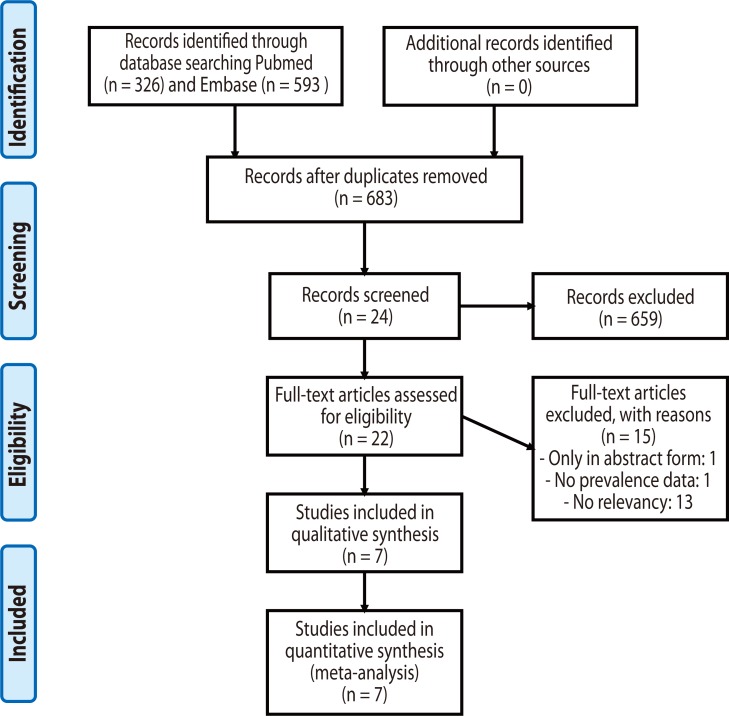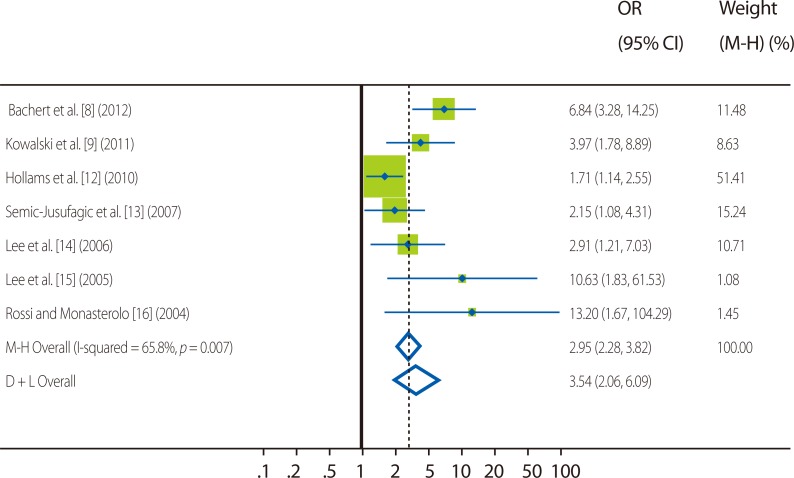Asia Pac Allergy.
2013 Apr;3(2):120-126. 10.5415/apallergy.2013.3.2.120.
Staphylococcal enterotoxin specific IgE and asthma: a systematic review and meta-analysis
- Affiliations
-
- 1Department of Internal Medicine, Seoul National University College of Medicine, Seoul 110-799, Korea. addchang@snu.ac.kr
- 2Institute of Allergy and Clinical Immunology, Seoul National University Medical Research Center, Seoul 110-799, Korea.
- 3Department of Internal Medicine, Pusan National University College of Medicine, Busan 602-739, Korea.
- 4Department of Internal Medicine, Seoul National University Bundang Hospital, Seongnam 463-707, Korea.
- KMID: 2400408
- DOI: http://doi.org/10.5415/apallergy.2013.3.2.120
Abstract
- BACKGROUND
Recent literature suggests that Staphylococcal enterotoxin specific IgE may be a risk factor for asthma.
OBJECTIVE
To investigate the associations between Staphylococcal enterotoxin sensitization and asthma.
METHODS
A systematic review and meta-analysis was performed for relevant case-control or population-based studies, published in the peer-reviewed journals until February 2013. Data were extracted on study designs, subjects, definitions and the prevalence of Staphylococcal enterotoxin sensitization.
RESULTS
A total of 683 studies were initially identified, of which 7 studies finally met the inclusion criteria (5 case-control and 2 population-based studies). All the included studies reported higher prevalence of the sensitization in asthmatics than in controls, despite clinical and methodological heterogeneity. In a meta-analysis, the pooled odds ratio of the sensitization for asthma was 2.95 (95% confidence intervals 2.28-3.82).
CONCLUSION
Staphylococcal enterotoxin sensitization was significantly associated with asthma. The mechanisms of associations warrant further elucidation.
Keyword
MeSH Terms
Figure
Reference
-
1. Anderson GP. Endotyping asthma: new insights into key pathogenic mechanisms in a complex, heterogeneous disease. Lancet. 2008; 372:1107–1119. PMID: 18805339.
Article2. Heederik D, von Mutius E. Does diversity of environmental microbial exposure matter for the occurrence of allergy and asthma? J Allergy Clin Immunol. 2012; 130:44–50. PMID: 22502794.
Article3. Brooks C, Pearce N, Douwes J. The hygiene hypothesis in allergy and asthma: an update. Curr Opin Allergy Clin Immunol. 2013; 13:70–77. PMID: 23103806.4. Wilson M. Bacteriology of humans: an ecological perspective. 2008. Malden, MA: Wiley-Blackwell.5. Bachert C, Gevaert P, van Cauwenberge P. Staphylococcus aureus enterotoxins: a key in airway disease? Allergy. 2002; 57:480–487. PMID: 12028112.
Article6. Boguniewicz M, Leung DY. Recent insights into atopic dermatitis and implications for management of infectious complications. J Allergy Clin Immunol. 2010; 125:4–13. PMID: 20109729.
Article7. Bachert C, Zhang N, Patou J, van Zele T, Gevaert P. Role of staphylococcal superantigens in upper airway disease. Curr Opin Allergy Clin Immunol. 2008; 8:34–38. PMID: 18188015.
Article8. Bachert C, van Steen K, Zhang N, Holtappels G, Cattaert T, Maus B, Buhl R, Taube C, Korn S, Kowalski M, Bousquet J, Howarth P. Specific IgE against Staphylococcus aureus enterotoxins: an independent risk factor for asthma. J Allergy Clin Immunol. 2012; 130:376–381.e8. PMID: 22738677.
Article9. Kowalski ML, Cieślak M, Pérez-Novo CA, Makowska JS, Bachert C. Clinical and immunological determinants of severe/refractory asthma (SRA): association with staphylococcal superantigen-specific IgE antibodies. Allergy. 2011; 66:32–38. PMID: 20973803.
Article10. Pastacaldi C, Lewis P, Howarth P. Staphylococci and staphylococcal superantigens in asthma and rhinitis: a systematic review and meta-analysis. Allergy. 2011; 66:549–555. PMID: 21087214.
Article11. Liberati A, Altman DG, Tetzlaff J, Mulrow C, Gøtzsche PC, Ioannidis JP, Clarke M, Devereaux PJ, Kleijnen J, Moher D. The PRISMA statement for reporting systematic reviews and meta-analyses of studies that evaluate health care interventions: explanation and elaboration. PLoS Med. 2009; 6:e1000100. PMID: 19621070.
Article12. Hollams EM, Hales BJ, Bachert C, Huvenne W, Parsons F, de Klerk NH, Serralha M, Holt BJ, Ahlstedt S, Thomas WR, Sly PD, Holt PG. Th2-associated immunity to bacteria in teenagers and susceptibility to asthma. Eur Respir J. 2010; 36:509–516. PMID: 20110393.
Article13. Semic-Jusufagic A, Bachert C, Gevaert P, Holtappels G, Lowe L, Woodcock A, Simpson A, Custovic A. Staphylococcus aureus sensitization and allergic disease in early childhood: population-based birth cohort study. J Allergy Clin Immunol. 2007; 119:930–936. PMID: 17292957.
Article14. Lee JY, Kim HM, Ye YM, Bahn JW, Suh CH, Nahm D, Lee HR, Park HS. Role of staphylococcal superantigen-specific IgE antibodies in aspirin-intolerant asthma. Allergy Asthma Proc. 2006; 27:341–346. PMID: 17063661.
Article15. Lee JH, Lin YT, Yang YH, Wang LC, Chiang BL. Increased levels of serum-specific immunoglobulin e to staphylococcal enterotoxin a and B in patients with allergic rhinitis and bronchial asthma. Int Arch Allergy Immunol. 2005; 138:305–311. PMID: 16224190.
Article16. Rossi RE, Monasterolo G. Prevalence of serum IgE antibodies to the Staphylococcus aureus enterotoxins (SAE, SEB, SEC, SED, TSST-1) in patients with persistent allergic rhinitis. Int Arch Allergy Immunol. 2004; 133:261–266. PMID: 14976395.17. Tee RD, Pepys J. Specific serum IgE antibodies to bacterial antigens in allergic lung disease. Clin Allergy. 1982; 12:439–450. PMID: 6982789.
Article18. Walker IC, Adkinson J. Study XIII: the relationship between the Cutaneous Reaction, Serum Agglutination Tests and Bacteriological Examination of the Sputum and Nasal Secretions in determining the part Staphylococcus Pyogenes Aureus and Albus may play in the cause of Bronchial Asthma. J Med Res. 1917; 36:295–308. PMID: 19972369.19. Virtue CM, Wittig HJ, Cook TJ. Lymphocyte transformation with bacterial antigens in intrinsic asthma. J Allergy Clin Immunol. 1971; 48:321–330. PMID: 4399176.
Article20. Bacigaluppi JE, Negroni R, de Severino HM. Bacterial allergy in allergic rhinitis and bronchial asthma. Ann Allergy. 1979; 42:95–98. PMID: 33586.21. Alam R, Kuna P, Rozniecki J, Kuzminska B. Bacterial antigens stimulate the production of histamine releasing factor (HRF) by lymphocytes from intrinsic asthmatic patients. Clin Exp Immunol. 1986; 63:241–248. PMID: 2420497.22. Beklemishev ND, Belyaev NN, Sukhodoeva GS, Bulvakhter YL. The mechanisms of bronchospasm in experimental microbial sensitization. I. Immunological stage. Allergol Immunopathol (Madr). 1984; 12:129–134. PMID: 6464938.23. del Real Sánchez JH. Controversy in asthma. I. Staphylococcus aureus as the main factor responsible for bronchospasm. Rev Alerg Mex. 1987; 34:89–97. PMID: 3324813.24. Brarda OA, Vanella LM, Boudet RV. Anti-Staphylococcus aureus, anti-Streptococcus pneumoniae and anti-Moraxella catarrhalis specific IgE in asthmatic children. J Investig Allergol Clin Immunol. 1996; 6:266–269.25. Hauk PJ, Hamid QA, Chrousos GP, Leung DY. Induction of corticosteroid insensitivity in human PBMCs by microbial superantigens. J Allergy Clin Immunol. 2000; 105:782–787. PMID: 10756230.
Article26. Mandron M, Ariès MF, Brehm RD, Tranter HS, Acharya KR, Charveron M, Davrinche C. Human dendritic cells conditioned with Staphylococcus aureus enterotoxin B promote TH2 cell polarization. J Allergy Clin Immunol. 2006; 117:1141–1147. PMID: 16675344.
Article27. Huvenne W, Callebaut I, Reekmans K, Hens G, Bobic S, Jorissen M, Bullens DM, Ceuppens JL, Bachert C, Hellings PW. Staphylococcus aureus enterotoxin B augments granulocyte migration and survival via airway epithelial cell activation. Allergy. 2010; 65:1013–1020. PMID: 20132156.
Article28. Huvenne W, Callebaut I, Plantinga M, Vanoirbeek JA, Krysko O, Bullens DM, Gevaert P, Van Cauwenberge P, Lambrecht BN, Ceuppens JL, Bachert C, Hellings PW. Staphylococcus aureus enterotoxin B facilitates allergic sensitization in experimental asthma. Clin Exp Allergy. 2010; 40:1079–1090. PMID: 20214664.
Article29. Herz U, Rückert R, Wollenhaupt K, Tschernig T, Neuhaus-Steinmetz U, Pabst R, Renz H. Airway exposure to bacterial superantigen (SEB) induces lymphocyte-dependent airway inflammation associated with increased airway responsiveness---a model for non-allergic asthma. Eur J Immunol. 1999; 29:1021–1031. PMID: 10092107.30. Yu J, Oh MH, Park JU, Myers AC, Dong C, Zhu Z, Zheng T. Epicutaneous exposure to staphylococcal superantigen enterotoxin B enhances allergic lung inflammation via an IL-17A dependent mechanism. PLoS One. 2012; 7:e39032. PMID: 22848348.
Article31. Hilty M, Burke C, Pedro H, Cardenas P, Bush A, Bossley C, Davies J, Ervine A, Poulter L, Pachter L, Moffatt MF, Cookson WO. Disordered microbial communities in asthmatic airways. PLoS One. 2010; 5:e8578. PMID: 20052417.
Article32. Huang YJ, Nelson CE, Brodie EL, Desantis TZ, Baek MS, Liu J, Woyke T, Allgaier M, Bristow J, Wiener-Kronish JP, Sutherland ER, King TS, Icitovic N, Martin RJ, Calhoun WJ, Castro M, Denlinger LC, Dimango E, Kraft M, Peters SP, Wasserman SI, Wechsler ME, Boushey HA, Lynch SV. National Heart, Lung, and Blood Institute's Asthma Clinical Research Network. Airway microbiota and bronchial hyperresponsiveness in patients with suboptimally controlled asthma. J Allergy Clin Immunol. 2011; 127:372–381.e1-3. PMID: 21194740.
Article33. Benoit M, Desnues B, Mege JL. Macrophage polarization in bacterial infections. J Immunol. 2008; 181:3733–3739. PMID: 18768823.
Article34. Sachse F, Becker K, von Eiff C, Metze D, Rudack C. Staphylococcus aureus invades the epithelium in nasal polyposis and induces IL-6 in nasal epithelial cells in vitro. Allergy. 2010; 65:1430–1437. PMID: 20456313.
Article35. Corriveau MN, Zhang N, Holtappels G, Van Roy N, Bachert C. Detection of Staphylococcus aureus in nasal tissue with peptide nucleic acid-fluorescence in situ hybridization. Am J Rhinol Allergy. 2009; 23:461–465. PMID: 19807976.
Article36. Hauk PJ, Wenzel SE, Trumble AE, Szefler SJ, Leung DY. Increased T-cell receptor vbeta8+ T cells in bronchoalveolar lavage fluid of subjects with poorly controlled asthma: a potential role for microbial superantigens. J Allergy Clin Immunol. 1999; 104:37–45. PMID: 10400837.37. Losol P, Kim SH, Hwang EK, Shin YS, Park HS. IL-5 Promoter polymorphism enhances IgE responses to staphylococcal superantigens in adult asthmatics. Allergy Asthma Immunol Res. 2013; 5:106–109. PMID: 23449963.
- Full Text Links
- Actions
-
Cited
- CITED
-
- Close
- Share
- Similar articles
-
- Association between specific IgE to staphylococcal enterotoxin B and the eosinophilic phenotype of asthma
- IL-5 Promoter Polymorphism Enhances IgE Responses to Staphylococcal Superantigens in Adult Asthmatics
- Association Between PTPN22 Polymorphisms and IgE Responses to Staphylococcal Superantigens in Chronic Urticaria
- Association of Specific IgE to Staphylococcal Superantigens with the Phenotype of Chronic Urticaria
- Effect of Staphylococcal Enterotoxin on the Development of Allergic Rhinitis in Mice



